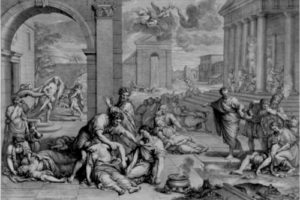The Story of the Great Contagion

- The onset and spread of COVID-19 seem new and extreme, but this is a tale as old as time.
- Today, Nicholas Vardy explains why this time feels different and offers some perspective and hope for wealth builders.
It came from the East, most likely from China. It emerged from the fluids of wild animals mixing in ways evolution never intended.
It radiated out in all directions: east, west, north and south.
It crossed borders, then oceans and then entire continents. No one, it seemed, would be spared.
Only one thing spread faster than the contagion, and that was the rumors of impending doom.
People panicked. Doctors were baffled. Government officials dawdled.
Festivals, gatherings and sporting events of all kinds were canceled. Economies collapsed. Civilization and its institutions were pushed to the precipice of downfall.
I am, of course, describing the Antonine Plague of A.D. 165 during the reign of the great Roman emperor and Stoic, Marcus Aurelius.
The Antonine Plague started with flu-like symptoms. It quickly morphed into something far more nefarious.
Authorities at the head of the most advanced civilization in history were woefully unprepared. Fear pervaded the empire.
Romans knew little about the spread of germs or disease. They burned incense, which they thought could keep them safe. Still, millions across the Roman empire died a gruesome and painful death.
Why does this story of ancient and obscure pestilence hit home?
I could have been describing today’s COVID-19 pandemic.
But I could have also been describing the Black Death (Bubonic Plague), the Spanish flu of 1918, or the cholera pandemics of the late 19th and early 20th centuries.
We all suffer from historical amnesia. Yet the COVID-19 pandemic would be a familiar story to our ancestors.
As Marcus Aurelius himself warned of future plagues in his book Meditations:
Bear in mind constantly that all of this has happened before… And will happen again – the same plot from beginning to end, the identical staging. Produce them in your mind, as you know them from experience or from history: the court of Hadrian, of Antoninus. The courts of Philip, Alexander, Croesus. All just the same. Only the people different.
Indeed, the later, greater Plague of Justinian from A.D. 541 to 542 would put the final nail in the coffin of the then already moribund Roman Empire.
Why COVID-19 Is Different
Yes, the arc of the COVID-19 story is a familiar one to scholars of Roman and medieval history.
But there are important ways that the COVID-19 pandemic is different.
Let me focus on three of them.
First, the sensationalist media in an interconnected world threw us all for a loop.
The No. 1 rule in media is that “if it bleeds, it leads.”
In 2005, I recall reading a headline that 50,000 would die in the U.K. due to mad cow disease. I also remember dismissing it with a laugh.
The actual death toll in the U.K. through 2014? 177.
This has led to a “boy who cried wolf” relationship with the press. It’s also what made early reports on COVID-19 easy to ignore.
But as in Aesop’s fable, the wolf eventually did show up. But by then, no one heeded the boy’s cries.
Second, today, the globe is far more interconnected than ever.
The Plague of Justinian, the Black Death and the Spanish flu all traveled along trade routes on slow-moving ships or in the bodies of soldiers.
In 2020, COVID-19 traveled from Wuhan, China, to Europe on 12-hour international flights.
It spread farther and faster than any plague had before.
High-profile public figures from Bill Gates to Nassim Taleb highlighted the dangers. As one expert put it, “There are only three things certain in life: death, taxes and a pandemic.”
We ignored them at our peril.
Third, let me highlight some good news.
Today, we have the benefit of modern medicine.
Yes, the virus travels fast. But so does the information on COVID-19 and reports on clinical experience with it.
When Ebola was first discovered, mortality rates were 90%. With intense treatment and extreme isolation measures, its mortality rate dropped to 40%.
Scientists sequenced the RNA of the COVID-19 virus in record time. Today, there are dozens of teams working on vaccines. Clinicians are working hard to repurpose existing medications.
A vaccine in record time is not a matter of “if” but “when.”
Two Lessons From COVID-19
These stories of plagues past and present are jarring.
Chalk that up to our collective hubris.
Americans worship progress. We view the evolution of human civilization as moving inevitably in some new and better direction. And we are both annoyed and terrified that a tiny bug can take us off our inevitable course.
Yet the story of COVID-19 is unfolding as if from an ancient script.
Authorities make the same mistakes. We succumb to the same fears. We endure the same grief and pain. And we will exult in the same relief when the current crisis passes.
Understanding the history of plagues may not offer an immediate solution.
But it does offer both perspective and hope.
For perspective, count your blessings. The Black Death killed 20 million people over five years. Smallpox killed some 400,000 people every single year of the eighteenth century. Measles killed 200 million people in the 19th and 20th centuries. The Spanish flu claimed 50 million souls in 1918.
The COVID-19 virus is a runny nose in comparison.
For hope, understand that humanity has endured far worse.
COVID-19 is not the apocalypse.
Humanity will survive.
Good investing,
Nicholas
P.S. For a prophetic documentary, I recommend Explained‘s “The Next Pandemic” on Netflix. If you want to take a deep dive into the history of plagues, I recommend The Great Courses’ The Black Death: The World’s Most Devastating Plague.
Stay informed with the latest news from Nicholas, including video updates where he shares his views on the current state of the markets. Simply like his Facebook page and follow @NickVardy on Twitter.






